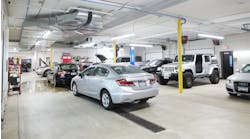Three factors — dramatically rising raw-materials costs, the weakened U.S. dollar and a slowdown in auto sales — are conspiring to turn 2008 into “one of the toughest years yet” in the auto industry, unless dramatic counter-measures are undertaken promptly. That’s according to a new study released today by AlixPartners LLP, titled the 2008 AlixPartners Global Automotive ReviewSM. The study shows that all manufacturers doing business in North America face as much as a $13 billion raw-inputs risk in 2008. About $7.5 billion of that risk falls at the feet of U.S. automakers and suppliers alone—an amount greater than their combined yearly operating income. Chief among the causes, about 60-70% of the total, is the doubling in steel prices in just the last five months, fed in part by industry consolidation and bottlenecks at key locations in various parts of the world for iron ore, coking coal and scrap recycling. “The overall spike in raw-materials costs equals $600-$900 finished per vehicle sold,” said John Hoffecker, a managing director of AlixPartners and co-head of the firm’s Performance Improvement Practice globally, “and, without counter-measures, that will either need to be passed onto consumers or taken out of the profits of suppliers and automakers alike.” Meantime, the study finds, while the weakened U.S. dollar may be good news for U.S. automotive exports, those exports are unlikely to come fast or strong enough to offset the added costs to OEMs and suppliers of goods they are presently importing—from raw materials to components to entire vehicles. The study finds that, driven by the weak dollar, BMW, Jaguar and Mercedes-Benz are today suffering up to a 40% hit to per-vehicle profitability for certain vehicles when imported into the U.S. versus sold in Europe. At the same time, it notes that some other foreign nameplates, while assembled in America, still have so little domestic content that they are now experiencing profitability shortcomings of similar proportions. “Foreign imports,” said Hoffecker, “that are suddenly forfeiting up to $20,000 a car in profitability in the U.S. market face two choices: either cut their allocations to the U.S., and thereby sacrifice hard-won market share, or rethink their sourcing and investment strategies and move faster toward more ‘natural hedging’—more local parts purchases and investments. Clearly, some are not moving fast enough.” Noting that the North American auto industry has not experienced a significant downturn in unit sales since 1991 (thanks in part to incentives keeping the market propped up), the study predicts a 1-million-unit drop-off this year. It also predicts that the profitability aspect of this fall will be magnified by more and more consumers switching from trucks and SUVs to smaller, lower-margin vehicles. Both this switch and lower overall industry volumes, it notes, will affect suppliers as well as automakers. The study predicts that although North American suppliers improved overall performance between 2006 and 2007, this year they are at great risk, absent dramatic actions, of seeing those gains wiped out. “We all thought times were already pretty difficult in this industry,” said Hoffecker, “but 2008 is shaping up to be one of the toughest years yet. The combination of unprecedented raw-materials spikes, the weak dollar and slowing economies around the world is going to make this a year that separates the strong from the weak. The impact can already be seen in Toyota’s first-quarter results and their downward forecast for the remainder of the year.” Another sobering finding in the study is that China is no longer quite the low-cost country it once was. With labor costs in China up 65% since 2004 and with a rapidly appreciated currency (especially against the U.S. dollar), the study shows that for many components manufacturing in Mexico is now more cost effective than manufacturing in China. The study notes too that there has been as much as a 16% swing in total export costs in less than a year for some components from China. “China remains, of course, a great market to be in, for many reasons,” said Hoffecker. “But if your company hasn’t already set up shop there, the decision to go is now much more difficult. At the very least, before ‘defaulting’ to China, companies today should be taking a very hard look at the other options out there in terms of low-cost sourcing.” “If today’s harsh environment has a silver lining,” said Hoffecker, “it’s that automotive companies and their owners alike now have the opportunity to make bold decisions that might have been previously unthinkable. They must unsentimentally review products, customers, programs, footprint and strategy for revenue and cost opportunities. They need to challenge their business structure and operating model, and move quickly.” Considered one of the most comprehensive studies of its kind, the AlixPartners analysis looked worldwide at 45 automakers, 22 heavy-truck producers, 273 auto suppliers and several conglomerates with significant automotive holdings, and measured and compared them across a wide range of operating as well as financial metrics. |



